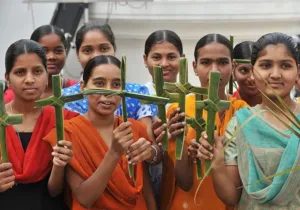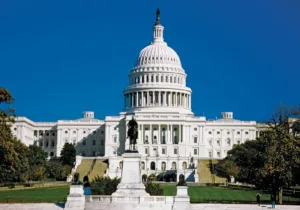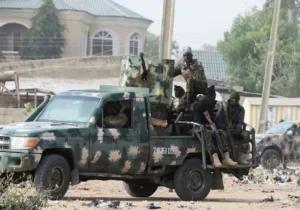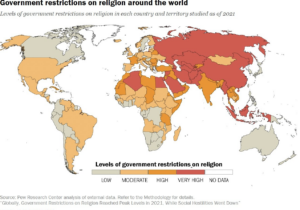India, the world’s largest democracy, is struggling to balance the rights and desires of its majority and minority populations. Such a challenge is common among all diverse democracies. Article 25(1) of India’s constitution provides that “subject to public order, morality and health and to the other provisions of this Part, all persons are equally entitled to freedom of conscience and the right freely to profess, practise and propagate religion.” There is, moreover, a long tradition of tolerance and respect for religious differences on the Indian subcontinent. Enshrined in the constitution and embodied by early national leaders such as Mahatma Gandhi and Jawaharlal Nehru, this tradition of religious tolerance, inflected as it was in Hindu ways (particularly for Gandhi), has always coexisted and had to contend with the more nativist views of politicians who feared such tolerance might lead to the displacement of the Hindu religion and culture from the center of Indian society.
Currently in India, politicians of the latter persuasion are ascendant and firmly in control of the central government. These politicians generally espouse the ideology of Hindutva (Hinduness). Often translated in simplified form for Western audiences as “Hindu nationalism,” the ideology of Hindutva asserts that the success of India depended historically, and will in the future depend, upon the degree to which it embraces its Hindu-ness (understood as both a religious and cultural reality). Those who embrace this ideology in its most extreme form find minority religions with “foreign” origins (primarily Islam and Christianity) a threat, and for this reason support policies aimed at limiting their numbers, power, and freedom.
The recent rise of such politicians therefore distresses many of India’s Christians and Muslims. At the same time, some of India’s laws restrict the religious freedom of majority Hindu institutions in ways that many Hindus find troubling. Much as in the United States, then, institutional religious freedom in India is an issue of concern to both majority and minority populations.
Restrictions on individual religious freedom in India are pervasive to such an extent that in the aggregate they affect religious institutions as well. Currently, for example, there are massive and ongoing protests against the Citizen (Amendment) Act, 2019 (CAA), passed in December 2019 by the ruling coalition led by the Bharatiya Janata Party (BJP) after its resounding reelection success earlier in 2019. The CAA provides a path to citizenship for illegal immigrants from Pakistan, Bangladesh, and Afghanistan, but explicitly excludes Muslims, establishing what is, in effect, a religious test for citizenship.
The BJP has also promised universal implementation of the National Register of Citizens (NRC), which when implemented in only one state (Assam) left nearly 2 million residents, mostly Muslim, unable to provide documentation sufficient to prove their citizenship. Collectively, then, these policies appear to Muslims and their supporters as part of a master plan to disenfranchise Muslims on a massive scale.
Similarly concerning is the sharp rise, over recent years, in mob attacks on Christian evangelists, cow vigilantism, and targeted lynchings of Muslims. As with the CAA-NRC issue, this increased violence primarily affects individuals. However, it has a chilling effect on religious institutions as well, in part because at least some of the attacks target entire congregations and places of worship.
There are, however, several issues of more direct relevance to institutional religious freedom in India, and below I highlight four. While the first three have primarily disquieted India’s religious minorities, the fourth has provoked anxiety among certain members of India’s majority Hindu community as well.
The Revocation of Article 370 – The CAA-NCP controversy came on the heels of the central government’s decision in August 2019 to revoke the special status of the state of Jammu and Kashmir (which lies along India’s border with Pakistan). This special status, enshrined in Article 370 of India’s constitution, allowed the majority-Muslim region a certain degree of autonomy. Critics contended that this limited autonomy prevented the central government from rooting out radicalized Muslims and stemming the infiltration of Muslim terrorists from Pakistan. Claiming a strong mandate from their 2019 reelection, the BJP quickly moved to revoke Article 370, immediately also invoking Section 144 of the Criminal Code of Procedure, under which it barred public assembly, squelched the internet, arrested Jammu and Kashmir state leaders, closed mosques, and detained Muslim clerics. At the time of this writing, these restrictions were still in force six months after being imposed. The relevance of these restrictions to those concerned about institutional religious freedom is clear.
State Freedom of Religion Laws – In the 1950s, Indian states began passing so-called “Freedom of Religion” laws (deemed “anti-conversion” laws by their critics) that prohibit conversion by “force, fraud, and inducement.” The problem is not so much with the letter of these laws—though some do require those wishing to convert themselves, or to convert others, to notify local authorities before doing so—as with the fact that “inducement” has been interpreted so widely as to include any offers of medical, vocational, or educational aid (including after conversion), or even threats of eternal damnation. This terminological imprecision also invites vigilantes to commit violence against those they perceive from a rather partisan perspective to be carrying out conversions involving inducement and leads to the regular filing of spurious cases against Christians, particularly those leading congregations experiencing membership growth. Many such Christian leaders or congregants have been detained and/or dragged through the courts for days or even weeks (frequently with disastrous financial ramifications). Such actions amount to a targeting of leaders of religious institutions and prevent congregations from fulfilling their religious obligations to proselytize.
The Foreign Contribution (Regulation) Act, 2010 (FCRA) – The FCRA requires that NGOs report the source of foreign contributions they receive and grants government officials the right to revoke their licenses to receive donations. Employed primarily for non-partisan monitoring and regulation in its earliest years, the FCRA has been used by the current government since it came to power to revoke the licenses of more than 20,000 NGOs, primarily for technical reporting violations or on charges of engaging in “undesirable activities against public interest.” (Click here to read one such decision.) Critics have noted that a large number of Muslim and Christian charities, as well as NGOs advocating for religious freedom on behalf of religious and other minorities, appeared both on the list of NGOs with revoked licenses and on the list of those whose renewal applications were denied. As a result of losing their licenses, many NGOs have now radically downsized their operations, or, like Compassion International (which was accused of being a front for Christian proselytization), shuttered their India operations altogether. In its current use, then, the FCRA has become a tool to restrict and harry both minority religious institutions and those who fight for their rights.
Governmental Management of Temples and the “Essential Practices” Doctrine – The government of independent India continued the British practice of regulating affairs at some Hindu temples, viewing them as cultural treasures and intervening in particular when there were claims that they were mismanaged or discriminated against low-caste or other devotees. Many Hindus resent this regulation, and in recent years, there have been a number of high-profile court battles over whether the government or temple priests should manage affairs at several famous temples (those dedicated to Jagannath and Nataraja among them). No recent cases have provoked as much controversy, however, as that over whether the Ayyappan Temple at Sabarimala should cease its practice of prohibiting females between the ages of 10 and 50 from entering (a prohibition predicated on devotees’ belief in Ayyappan’s divine yogic celibacy).
In September 2018, the Supreme Court weighed in, declaring that the exclusion of women was discriminatory and thus not a protected practice under freedom of religion statutes. Such an exclusion, the Court initially reasoned, was not an “essential practice” of Hinduism. After an extraordinary outpouring of dissent, however, the Supreme Court took the unusual step of referring the decision for review before a seven-judge panel, which is currently reconsidering the case. The Supreme Court’s decision was troubling to many of those concerned about institutional religious freedom (even to some of those who personally found the exclusion of women objectionable) because it represented an entrenchment of the notion that judges had the ability and power to determine what, within any particular religion, constituted an essential practice. (See this excellent academic article for more on the historical development of the “essential practices” doctrine.)
These are, of course, complex issues that are difficult to resolve because they can easily be framed in ways that counterpoise majority-to-minority interests, and the ideal of religious freedom to the ideal of gender, caste, and class equality. Nevertheless, each of these four situations features intrusive governmental intervention into religious affairs. Therefore, while heightened tensions between India’s majority and minority religious communities make perfect solidarity among them unlikely, there is perhaps some hope of generating unity around a platform aimed at expanding institutional religious freedom while reducing governmental regulation of religious behavior.





